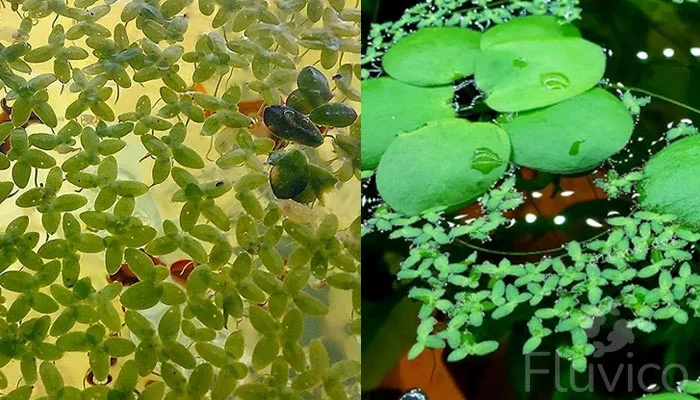
Table of Contents
Origin and Habitat of Duckweed
Duckweed is native to almost every part of the world except for the extremely cold regions such as Antarctica. It thrives in temperate and tropical climates and is commonly found across Europe, North America, Asia, Africa, and Australia.
The preferred habitat of duckweed includes still or slow-moving bodies of freshwater like ponds, lakes, marshes, and slow-moving rivers or streams. Duckweed has the ability to adapt to various water conditions but prefers nutrient-rich environments.
These conditions can often be found in areas where there is a lot of agricultural or residential runoff. One of the remarkable characteristics of duckweed is its ability to quickly colonize and cover a water surface, especially in nutrient-rich conditions.
This makes it an excellent candidate for nutrient removal in wastewater treatment facilities, but also means it can be problematic in natural water bodies if its growth becomes unchecked.
Related: View our latest Aquarium Plant Guides Here!
Species Information and Conservation Status
Duckweeds belong to the family Lemnaceae. There are approximately 40 known species of duckweed divided among five genera: Spirodela, Landoltia, Lemna, Wolffiella, and Wolffia. Each genus differs in size, number of roots, shape, and reproductive strategies.
For example, Spirodela is generally larger with multiple roots, while Wolffia, often referred to as watermeal, is the smallest flowering plant and lacks roots entirely.
Despite its ubiquitous presence in water bodies worldwide, the conservation status of individual duckweed species varies. Some species are quite common, while others are rare and may be considered threatened in certain regions.
For instance, in the UK, the ivy-leaved duckweed (Lemna trisulca) is classified as “Near Threatened” on the Vascular Plant Red Data List for Great Britain. Duckweed’s conservation status isn’t usually a significant concern, given its rapid reproduction rate and wide distribution.
However, specific local conditions, including pollution, habitat destruction, and climate change, could impact localized duckweed populations.
How to Identify Common Duckweed
Identifying common duckweed, often known as Lemna minor, is relatively straightforward once you know what to look for. Here’s a quick guide:
- Size and Shape: Duckweed is typically small, with each individual plant measuring only about 1/8 to 1/4 inch across. The plant has a simple, flat, oval, or round shape that floats directly on the water’s surface.
- Color: The color of duckweed can range from bright green to a darker green, depending on the plant’s age and the water conditions. If the plant is nutrient-starved or stressed, it may turn a yellowish color.
- Structure: Duckweed has a simple structure with a single “frond” or “leaf” (although it’s technically not a true leaf) and a single root (or occasionally a few roots) that hangs down into the water.
- Roots: Look for tiny, hair-like roots that dangle below the water’s surface from each frond. In Lemna minor, there’s typically just one root per frond.
- Flowering: Although it’s rare, duckweed can produce small, simple flowers. If you spot a tiny, three-parted flower on the plant, it’s a good sign you’ve found duckweed.
- Growth Pattern: One of the key characteristics of duckweed is its rapid growth. In the right conditions, it can quickly form a dense mat on the water’s surface.
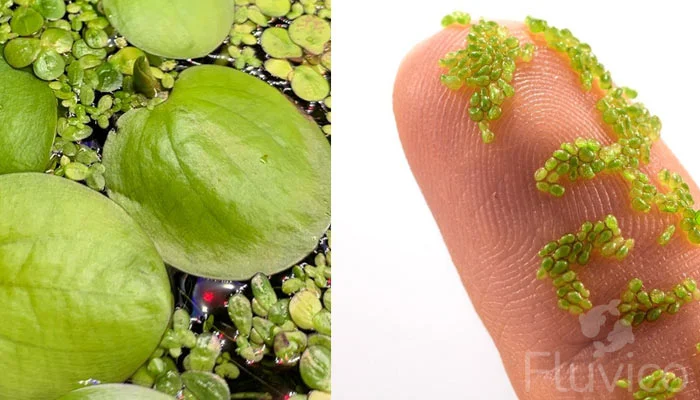
Types of Duckweed
There are about 40 known species of duckweed spread across five genera: Spirodela, Landoltia, Lemna, Wolffiella, and Wolffia.
- Spirodela: Also known as giant duckweed, this genus has a larger size compared to other duckweeds, with each plant having several roots. The most common species is Spirodela polyrhiza.
- Landoltia: This genus has only one species, Landoltia punctata, also known as dotted duckweed. It is similar to Spirodela but is distinguished by a small extension, or “papule”, on the upper surface of each frond.
- Lemna: Lemna is the genus that people most commonly refer to when talking about duckweed. One of the most common species is Lemna minor, or lesser duckweed, which is small with one root per frond.
- Wolffiella: The duckweeds in this genus are unique because they are rootless. Species in this genus include Wolffiella lingulata and Wolffiella gladiata.
- Wolffia: Wolffia includes the smallest species of duckweed. These plants are rootless and nearly microscopic. An example species is Wolffia globosa, also known as Asian watermeal.
Each type has unique characteristics that allow it to thrive in specific environments. While they share many similar traits, there are subtle differences in their appearance, size, and the specific conditions they prefer.
Duckweed in Aquatic Ecosystems
Duckweed, though small in size, plays a significant role in aquatic ecosystems. It provides shelter and food for a variety of wildlife, including fish, insects, and birds. It’s also known to help with nutrient cycling, absorbing excess nutrients from the water, which can help in water purification efforts.
However, despite these ecological benefits, duckweed’s rapid growth can lead to several problems. 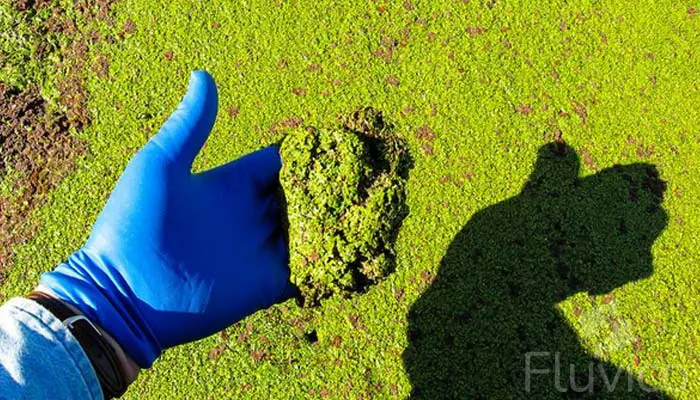
Problems Associated with Duckweed
- Overcrowding and Light Blockage: Duckweed reproduces rapidly, quickly covering the surface of the water. This dense coverage can block sunlight from reaching other aquatic plants and organisms that rely on it for photosynthesis, potentially leading to a decline in biodiversity.
- Oxygen Depletion: While duckweed produces oxygen during the day through photosynthesis, it also consumes oxygen at night. In overgrown conditions, this could lead to oxygen depletion in the water, threatening fish and other aquatic organisms.
- Algal Blooms: Duckweed’s nutrient absorption can sometimes contribute to the development of algal blooms. When duckweed dies and decays, it releases the nutrients it absorbed back into the water, potentially causing an explosive growth of algae.
- Aesthetics and Navigation: For pond owners, an overgrowth of duckweed can be unsightly and even hinder recreational activities such as boating or fishing.
- Maintenance Challenges: Once established, duckweed is difficult to remove completely. Even a small amount left behind can lead to a new overgrowth.
Benefits of Duckweed
- Water Purification: Duckweed is excellent at absorbing excess nutrients from the water, including nitrates, phosphates, and even heavy metals. This makes it particularly useful in water purification and wastewater treatment contexts.
- Food Source: Duckweed is rich in protein and can serve as an efficient food source for fish and other aquatic animals. In certain conditions, it is even harvested and used as a feed supplement for poultry and cattle.
- Habitat Provision: Duckweed provides a habitat for numerous aquatic species. It offers a breeding ground for insects and a hiding place for small aquatic creatures, promoting biodiversity.
- Carbon Sequestration: Like all plants, duckweed absorbs carbon dioxide from the atmosphere and releases oxygen, playing a role in combating climate change.
- Biofuel Production: Research is ongoing into using duckweed as a source of biofuel due to its fast growth rate and high starch content.
- Pharmaceutical Potential: Certain types of duckweed produce compounds with potential medicinal properties, leading to its use in traditional medicine in some cultures and interest from pharmaceutical researchers.
- Aquaponics Systems: In aquaponics, duckweed can serve a dual purpose, cleaning the water by absorbing excess nutrients, and serving as a food source for fish.
So, while controlling duckweed growth is necessary to prevent it from overwhelming ponds or lakes, it’s also worth remembering the many benefits that this tiny plant can bring.
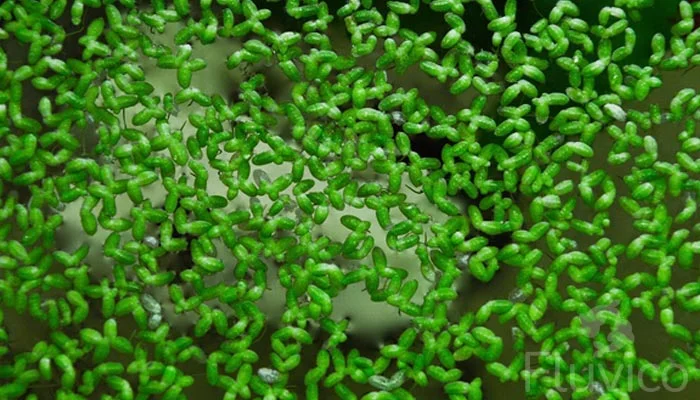
Tank Requirements and Water Parameters for Duckweed
Tank Size
- Duckweed doesn’t require a large amount of space and can grow in various sizes of tanks or ponds.
- However, remember that in smaller tanks, duckweed can quickly cover the water surface, which may not be desirable.
Lighting
- Duckweed needs ample lighting for photosynthesis but can adapt to a range of light conditions, from low to bright.
- However, it grows fastest in high light conditions.
- Be cautious though, as excessive light, especially without a corresponding level of nutrients, can cause problems like algal blooms.
Substrate
- As a floating plant, duckweed doesn’t require substrate to grow.
- Its roots take in nutrients directly from the water column.
Water Flow
- Duckweed prefers still or slow-moving water and may struggle in environments with strong water flow or turbulence.
- If the water is too turbulent, the plants can be submerged and may have difficulty recovering.
CO2 and Fertilizer Application
- CO2: Duckweed will benefit from the addition of CO2 but it is not a requirement. This plant is quite adept at growing in low CO2 environments.
- Fertilizers: Duckweed appreciates nutrient-rich environments and will quickly utilize nitrates and phosphates in the water. In tanks where nutrients are limited, a balanced liquid fertilizer can promote growth.
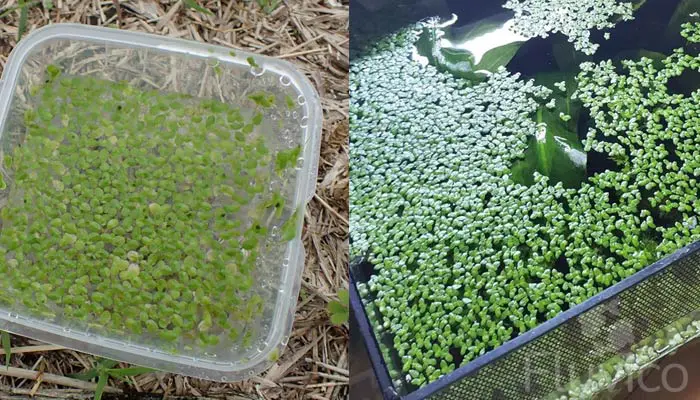
Planting and Propagation of Duckweed
Quarantining Duckweed
When you bring home new duckweed, it’s crucial to quarantine it before adding it to your main tank, pond, or water feature. This prevents potential disease or pest introduction into your system. Check out the below step bu step guide.
- Prepare a Quarantine Tank: This can be a simple container filled with dechlorinated water. The size depends on how much duckweed you have, but even a clean, unused bucket can work for small quantities. Make sure to provide adequate light.
- Inspect the Duckweed: Look for signs of disease or pests, such as discolored fronds, insects, or snails.
- Clean the Duckweed: Rinse the duckweed thoroughly in clean, dechlorinated water to remove any loose debris or potential pests.
- Place in Quarantine: Add the cleaned duckweed to the quarantine tank.
- Monitor the Duckweed: Over the next one to two weeks, watch the duckweed for signs of disease or pests. Healthy duckweed should multiply and cover the surface of the water within a few days.
- Introduction to Main Tank or Pond: If the duckweed is growing well and shows no signs of pests or disease after quarantine, it can be added to your main tank or pond.
- Ongoing Monitoring: Continue to monitor the duckweed for any changes once it’s in your main system.
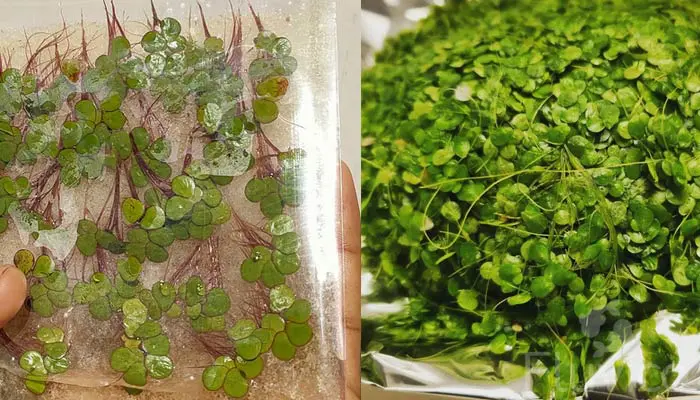
Planting Duckweed
- No Soil Required: Duckweed is a free-floating plant, meaning it does not require planting in soil.
- Add to Water Surface: Simply add your duckweed to the surface of your pond or aquarium.
- Spread Evenly: Try to spread it out evenly to allow each plant access to light.
Related: View our latest Aquarium Plant Guides Here!
Propagation of Duckweed
Duckweed propagates itself asexually and quickly under favorable conditions.
- Asexual Reproduction: Each duckweed plant produces buds that grow into new plants. This happens continuously as long as conditions are suitable.
- Rapid Growth: A small amount of duckweed can multiply to cover a large surface area in a short time.
- Control Measures: You may need to periodically remove excess plants to prevent overcrowding and maintain a balance with other organisms in your aquatic ecosystem.
- Spreading to New Areas: If you want to spread duckweed to another pond or aquarium, simply scoop some up and place it on the water surface of the new location.
Duckweed Care Guide
Duckweed care primarily involves offering plenty of light, keeping water conditions moderate, and avoiding strong currents. It thrives in nutrient-rich environments and can benefit from CO2 and liquid fertilizers, but it’s also important to manage its rapid growth to prevent overcrowding. 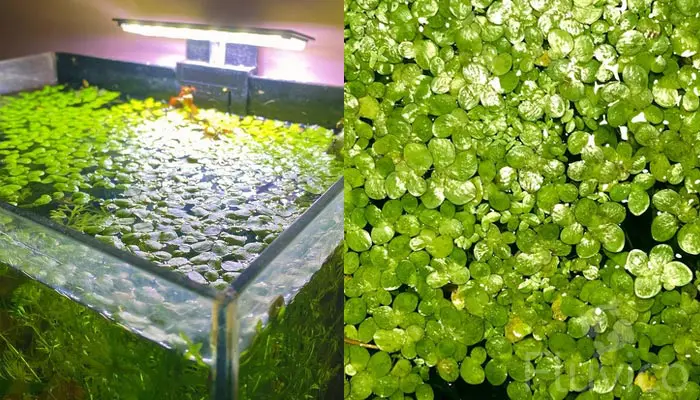
Water Type, Temperature, Hardness, and pH
- Duckweed can tolerate a range of water conditions, making it versatile for different setups.
- Temperature: It thrives in temperatures between 15°C and 30°C.
- Hardness: Duckweed can grow in both hard and soft water conditions.
- pH: Duckweed prefers a slightly acidic to neutral pH, in the range of 6.0-7.5.
Fertilizer
- Nutrient-rich environments: Duckweed grows best in these conditions.
- Absorption of nutrients: It efficiently takes in nitrates and phosphates from the water, acting as a natural fertilizer.
- Addition of liquid fertilizer: In tanks where nutrients are limited, this can promote growth.
- Over-fertilization caution: Excessive fertilizers could trigger an overgrowth of duckweed or cause algal blooms.
- Regular monitoring: Keeping track of nutrient levels in the water is important to maintain balance.
- High nutrient uptake: While duckweed can benefit from fertilizers, they’re not always necessary due to its efficient nutrient absorption.
Pruning Common Duckweed
- Overgrowth: Duckweed tends to grow rapidly and can easily overrun your tank or pond, so regular pruning is essential.
- Removal: Use a net or skimmer to gently scoop out excess duckweed from the water surface.
- Consistent checks: Regularly check your tank or pond for overgrowth and prune as necessary.
- Balancing act: Pruning helps maintain a balance of duckweed, allowing enough plants for their benefits without letting them block sunlight for other aquatic life.
- Disposal: Dispose of pruned duckweed responsibly, as it can become invasive in natural water bodies. Never dump it in natural waterways.
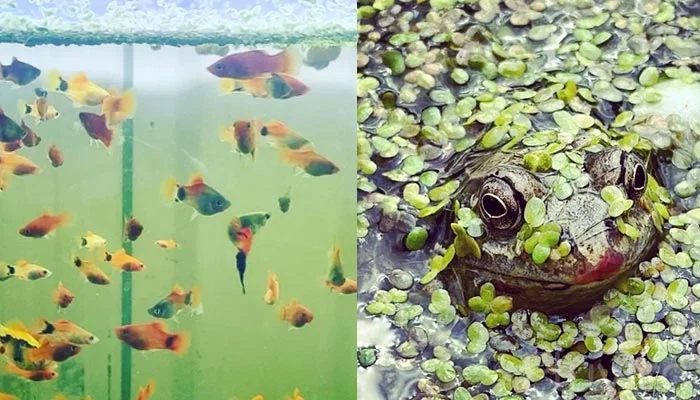
Duckweed and Compatible Tankmates
- Herbivorous Fish: Species like goldfish and koi not only tolerate duckweed but can also use it as a food source.
- Shrimp: Many types of shrimp can eat duckweed and benefit from its nutritional content.
- Certain Aquatic Snails: Some snail species don’t mind the presence of duckweed and might even feed on it.
- Frogs & Turtles: Certain amphibians and reptiles, such as frogs and turtles, may coexist well with duckweed.
- Other Floating Plants: Duckweed can live alongside other floating plants, but remember, duckweed can shade out other plants if it covers the water surface completely. Regular pruning is necessary to ensure light reaches other plants.
How to Control or Get Rid of Duckweed
While duckweed can be beneficial, its rapid growth may lead to overcrowding, requiring you to take steps to control or even get rid of it. Here are some strategies:
Control Measures:
- Regular Pruning: Remove excess duckweed manually using a net or skimmer to prevent overcrowding.
- Introduce Duckweed Consumers: Certain fish and shrimp species can help control duckweed by feeding on it.
- Balanced Lighting and Nutrient Levels: Regulating light and nutrient levels can slow duckweed’s growth rate.
Getting Rid of Duckweed:
- Physical Removal: For small ponds or aquariums, physically removing duckweed is the most direct approach. You can use a fine-mesh net or similar tool to scoop out the plants.
- Chemical Treatments: There are herbicides specifically designed to kill duckweed, but these should be used as a last resort and with caution as they can also affect other plants and aquatic life.
- Biological Control: Certain animals, such as grass carp or domesticated ducks, can eat significant amounts of duckweed and help clear it from a pond. However, this requires careful consideration of the potential impacts on the overall ecosystem.
Remember, any control or removal process should be followed up with regular monitoring to ensure the duckweed doesn’t quickly return to problematic levels. 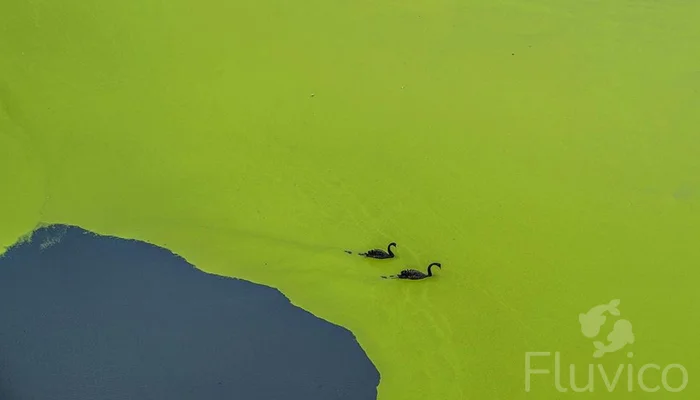
FAQ
Why is Duckweed a Problem?
Duckweed’s rapid growth can cover water surfaces, blocking sunlight for other plants and disrupting oxygen levels, potentially harming aquatic life. It can also clog filters and pumps, posing maintenance challenges in ponds and aquariums. Therefore, managing its growth is essential for a balanced ecosystem.
Is Duckweed algae?
No, duckweed is not algae. Duckweed is a family of small, free-floating plants called Lemnaceae, while algae is a diverse group of aquatic organisms that conduct photosynthesis. Despite both being water-based, they are distinct forms of life.
Why is my Duckweed dying?
Duckweed might die due to unfavorable conditions such as poor water quality, lack of nutrients, inadequate light, extreme temperatures, or strong water currents. Addressing these factors and maintaining balanced conditions are crucial for duckweed’s survival and growth.
Can duckweed grow in soil or on land?
No, duckweed cannot grow in soil. It is a free-floating plant that grows on the surface of still or slow-moving bodies of water, like ponds or aquariums. It absorbs nutrients directly from the water through its underside.
More Reading

15 Types of Cryptocoryne: Which is Best For Your Aquarium Setup?

16 Awesome Low Light Aquarium Plants (Mosses, Ferns & Stem Plants)


18 Types of Aquarium Moss: Photos, Care, Propagation & Growth Guide
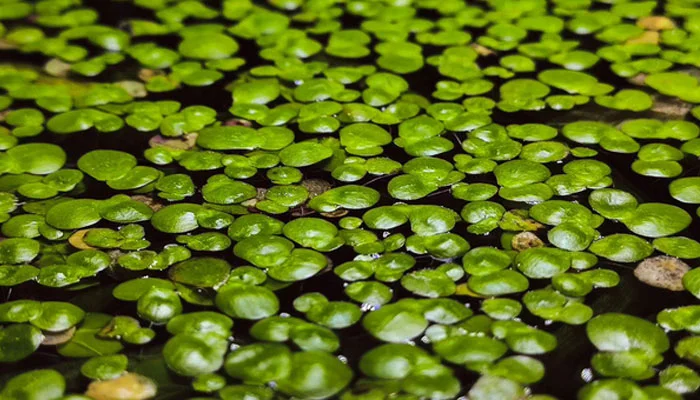
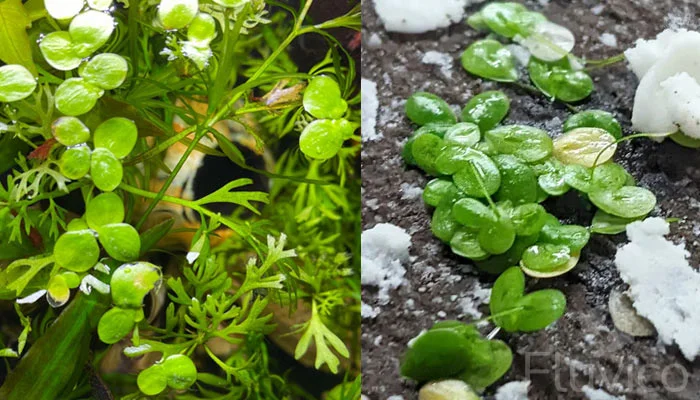
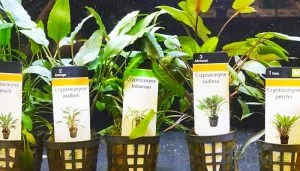
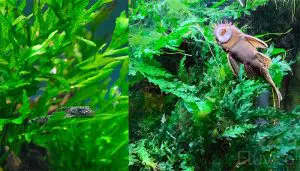
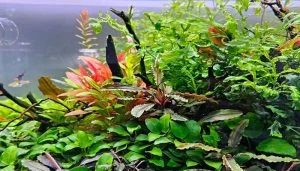
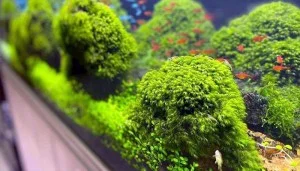
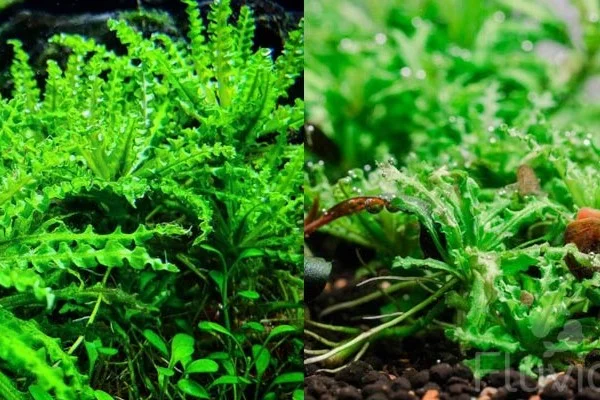
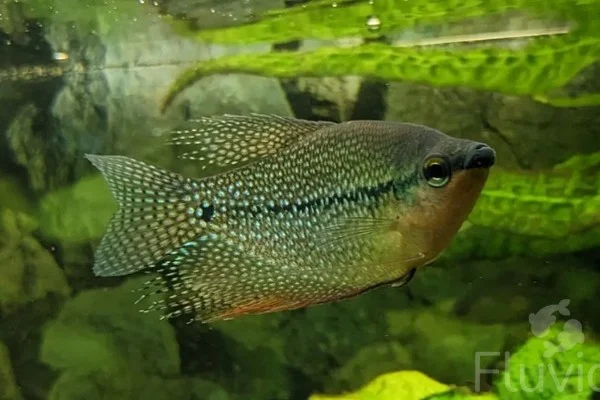
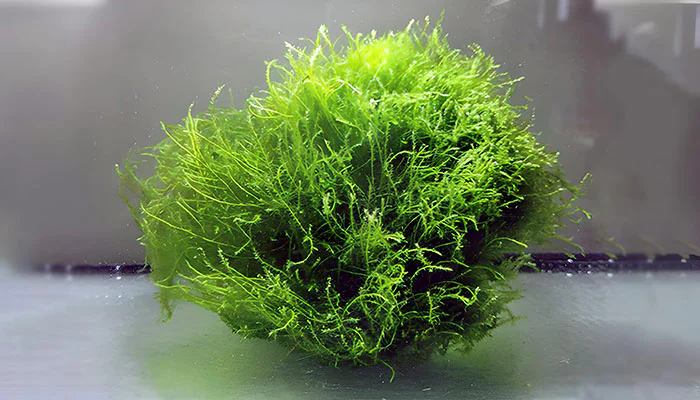
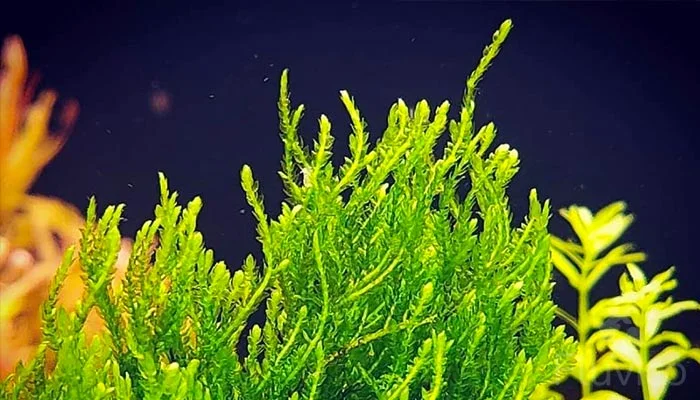
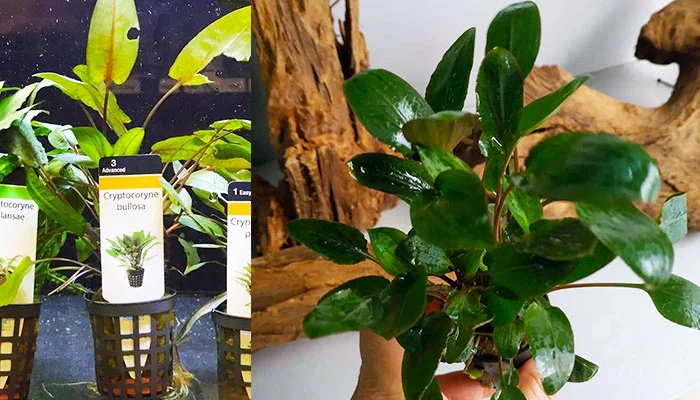
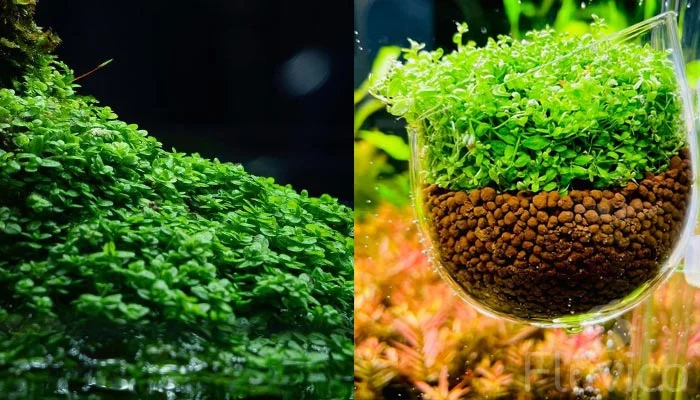
Hope you enjoyed our Duckweed Care Guide! As always if you have any questions or tips of your own, comment below.
All the best,
Charlie